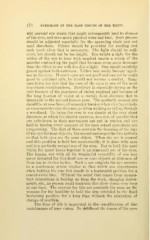Page 310 - My FlipBook
P. 310
174 PATHOLOGY OF THE HAED TISSUES OF THE TEETH.
will prevent eye strain that might subsequently lead to disease
of the eyes, and save much physical wear and tear. Such glasses
should be adjusted especially for the operating chair and not
used elsewhere. Others should be provided for reading and
such work when that is necessary. The light should be suffi-
cient, but should not be too bright. Too bright a light for the
retina of the eye to bear with comfort causes a strain of the
muscles contracting the pupil that becomes even more tiresome
than the effort to see with too dim a light. One should carefully
guard against both extremes. Either may easily become injuri-
ous to the eyes. If one's eyes are not good and can not be made
good by artificial aids, he should not become a dentist. Many
men learn too late that the care of the eyes is one of the most
important considerations. Dentistry is especially trying on the
eyes because of the exactness of vision required and because of
the long fixation of vision at a certain fixed distance that is
unnatural to the normal human eyes. The perfectly normal eye
should be at ease from all muscular tension when viewing objects
at some considerable distance, as when walking or riding through
a woodland. To bring the eyes to see clearly at the very short
distances at which the dentist operates, two sets of muscles that
are coordinate in their movements are put in tension and are
held in tension every moment of the time actual operations are
progressing. The first of these controls the focusing of the lens
of the eye for near objects ; the second converges the two eyeballs
so that both eyes see the near object. "When the eye is normal
and this position is held but momentarily, it is done with ease
and is a perfectly normal use of the eyes. But to hold this near
vision for many hours together is an abnormal use of the eyes.
The human eye with all its wonderful versatility of use was
never intended for this fixed use on near objects at distances of
from ten to twelve inches. Such a use subjects the eye muscles
to a continuous strain similar to that which one experiences
when holding his arm full length in a horizontal position for a
considerable time. "Without the relief that comes from momen-
tary relaxations in looking up from the work, changing instru-
ments, etc., no person could maintain this close vision very long
at one time. The reasons for this are precisely the same as the
reasons for the inability to hold the arm extended in the fixed
horizontal position for a long time without the relaxation of
change of position.
The time of life is important in the consideration of this
maintenance of near vision. In childhood the lenses of the eves


